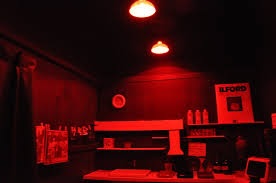
Sidwell Friends
The Sidwell darkroom has been closed since 2020.
In 2020, following concerns from students and faculty about the ventilation system in the darkroom, Sidwell barred students from printing film inside the space. Initially, students could still roll film — a process that only requires a dark space — but concerns about student health prompted Sidwell to officially close the space in 2022, according to Upper School Photography Teacher Lely Constantinople. Now, nearly four years later, discussions surrounding the reopening of the darkroom are ongoing, but the school remains hopeful it can reopen the space as soon as the Fall of 2026, said Head of School Bryan Garman.
After reporting the ventilation issue in 2011, Constantinople initially worked with the administration to address the problem, installing a hood over the darkroom sink to draw chemical fumes up to the roof and outside the building. However, according to Constantinople, “after years of tolerating it, the open air chemistry and lack of adequate ventilation became more and more noticeable.” Constantinople and students alerted the administration of the ongoing issue, prompting Sidwell to hire an independent environmental engineering firm to assess the ventilation system. Initially, the school told her the darkroom would be closed in 2020, she said. Soon after, the school transitioned to distance learning, shelving the issue. “I knew it wasn’t going to be fixed right away, and because of the pandemic, I knew that it would be shelved for a while,” she added. “But when we returned to campus in early 2021, I had to keep raising the issue to see what the school’s plan was to address its closure.”
When students returned after the pandemic, they could still roll film inside the darkroom and then process it in the classroom. However, after a shadow student felt faint in the fall of 2022, Sidwell officially shut down the darkroom for film rolling a few days after. According to Constantinople, its closure had a significant impact on the structure of her classes. Previously, analog components comprised about 50% of the photography curriculum, forcing Constantinople to redesign the program amid ongoing discussions with the administration.
While Constantinople is “sympathetic” to the school’s different priorities, she is confused about how the issue keeps getting “kicked down the road when the photo program is the most popular and the most populated arts program for a decade.”
According to Garman, fixing the darkroom would require a complex exhaust system, a project he describes as “expensive to build, maintain, and repair.” During a 2021 campaign to reopen the darkroom, the administration informed Andrew Ludwin ’23 that the renovations would cost nearly $125,000, primarily due to the darkroom’s location beneath the RLS Meeting Room.
During the discussions with the contractors, Constantinople says that she was “told not to be in that conversation,” even though she had initially raised the issue. “I really don’t understand why the classroom teacher can’t be involved in those kinds of discussions,” she said. Despite the delay, Upper School Principal Robert Gross says the school remains committed to reopening the darkroom. “The goal has always been to try to bring film processing back to the Kogod Arts Center,” Gross said. Concerns around renovating the existing darkroom prompted Gross and others to consider building new photography facilities at a different location in Kogod. “It may actually be a cleaner possible solution just to move it and to explore ventilating in a new space,” he said.
According to Gross, Sidwell cannot begin construction on a new darkroom until the completion of the Upton campus, currently scheduled for the summer before the 2026-2027 school year. He added that this will open up classrooms in Kogod that are currently used for academic classes, including K19 and K20, which could potentially be the sites of a new darkroom and photography studio. In the meantime, Garman said, “We will continue to invest in the photography program, which we have done since the lab was closed, and assure that students have high-quality digital equipment.” Without the darkroom, however, students feel that the curriculum is incomplete, preventing them from receiving the same education as previous students. “The dark room being unusable has made it hard to fully understand the art of photography,” senior Sidney Heiges explained. “Initially, it was the exhilarating feeling of fiddling around with the film in your hands in the dark that drew me into photography, but without it, the curriculum lacks the same vigor.” “It has really harmed the depth of my photography experience,” junior Kai Schropfer added. “A big part of any art experience is the medium’s history, which is undoubtedly true for photography.”Previously, the darkroom was a pivotal part of the photography curriculum, said Ludwin. According to Ludwin, the class began working with a pinhole camera each year before eventually transitioning into film, a process he believes is crucial to the learning process. Through this structure, explained Ludwin, students learned the key components of the film development process, gaining an intricate understanding of the inner workings of photography.
“The dark room was the only way to get that hands-on experience,” he added. “The exposure to the darkroom made me a much more intentional photographer.” According to Constantinople, “the darkroom is the historical language of photography, and not having the experience of slower and more intentional practice is a real loss to a student’s fine arts education.” Constantinople and students remain optimistic that the darkroom will reopen, but each year, the sense of optimism dissipates in the community. The majority of students in the Class of 2026 are set to be the first class to graduate in over a decade without the opportunity to print or roll film in the darkroom, she explained.